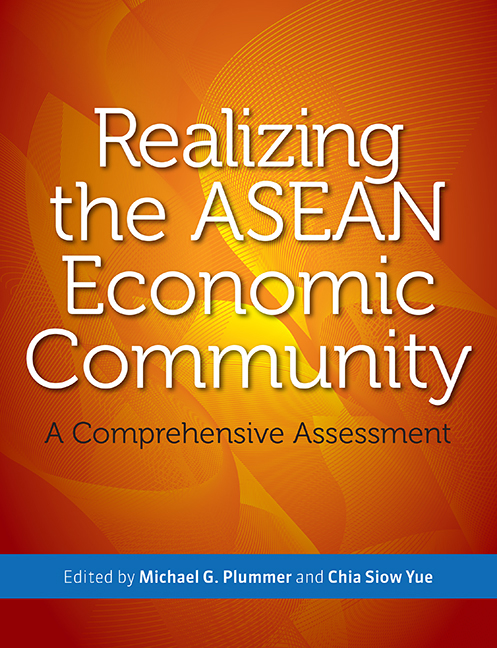Book contents
- Frontmatter
- Contents
- Illustrations
- Foreword
- Executive Summary
- Acknowledgements
- About the Contributors
- 1 Introduction
- 2 Regional Market for Goods, Services, and Skilled Labor
- 3 Competition Policy, Infrastructure, and Intellectual Property Rights
- 4 The AEC and Investment and Capital Flows
- 5 Narrowing the Development Gap in ASEAN
- 6 Competitiveness and Leverage
- 7 Benefits of the AEC
- References
- Appendix A AEC Components
- Appendix B The CGE Model
- Appendix C Developments in Logistics and Aviation
- Appendix D AEC Blueprint Excerpt
- Appendix E ASEAN Free Trade Agreements
- Appendix F ASEAN Member States' Free Trade Agreements
- Appendix G ASEAN Imports and Exports, 2000 and 2006
- Index
Appendix B - The CGE Model
Published online by Cambridge University Press: 21 October 2015
- Frontmatter
- Contents
- Illustrations
- Foreword
- Executive Summary
- Acknowledgements
- About the Contributors
- 1 Introduction
- 2 Regional Market for Goods, Services, and Skilled Labor
- 3 Competition Policy, Infrastructure, and Intellectual Property Rights
- 4 The AEC and Investment and Capital Flows
- 5 Narrowing the Development Gap in ASEAN
- 6 Competitiveness and Leverage
- 7 Benefits of the AEC
- References
- Appendix A AEC Components
- Appendix B The CGE Model
- Appendix C Developments in Logistics and Aviation
- Appendix D AEC Blueprint Excerpt
- Appendix E ASEAN Free Trade Agreements
- Appendix F ASEAN Member States' Free Trade Agreements
- Appendix G ASEAN Imports and Exports, 2000 and 2006
- Index
Summary
In this appendix, we provide details regarding the CGE model used in Chapter 2.
PRODUCTION AND TRADE
Agriculture, mining, and government services sectors are assumed to exhibit perfect competition. In each of these sectors, there is a representative firm operated under constant returns to scale technology. Trade is modeled using the Armington assumption for import demand. The manufacturing and private services sectors are characterized by monopolistic competition, and their structure of production and trade follows Melitz (2003). Each sector with monopolistic competition consists of a continuum of firms that are differentiated by the varieties they produce and their productivity. Firms face fixed production costs, resulting in increasing returns to scale. There is also a fixed cost and a variable cost associated with the exporting activities. On the demand side, the agents are assumed to have Dixit- Stiglitz preference over the continuum of varieties. As each firm is a monopolist for the variety it produces, it sets the price of its product at a constant markup over its marginal cost. A firm enters domestic or export markets if and only if the net profit generated from its domestic sales or exports in a given country is sufficient to cover the fixed cost. This zero cutoff profit condition defines the productivity thresholds for firms entering domestic and exports markets, and in turn determines the equilibrium distribution of non-exporting firms and exporting firms, as well as their average productivities. Usually, the combination of a fixed export cost and a variable (iceberg) export cost ensures that the exporting productivity threshold is higher than that for production for domestic market (i.e., only a small fraction of firms with high productivity are in export markets). These firms supply both domestic and export markets. We assume there is no entry or exit of firms in these monopolistic sectors (i.e., the number of firms is fixed).
- Type
- Chapter
- Information
- Realizing the ASEAN Economic CommunityA Comprehensive Assessment, pp. 193 - 194Publisher: ISEAS–Yusof Ishak InstitutePrint publication year: 2009

